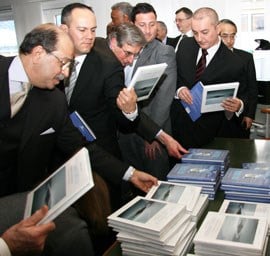Norway’s High North strategy: Presence, Activity and Knowledge
Historical archive
Published under: Stoltenberg's 2nd Government
Publisher: Ministry of Foreign Affairs
Briefing to ambassadors accredited to Norway in the Foreign Ministry on 27 January 2009
Speech/statement | Date: 28/01/2009
Minister of Foreign Affairs Jonas Gahr Støre gave on Tuesday 27 January a presentation on Norwegian High North Policy to ambassadors accredited to Norway.
Foreign Minister's talking points
Check against delivery
Introduction
- Topics for today: global warming and Arctic; energy and transport; legal framework; importance of cooperation; and update on Norway's thinking about these issues.
 Recent developments
Recent developments
- Icecap melting faster than expected.
- Increased international interest continues. United States (Arctic strategy), EU and Russia (policy statements). Asian countries: Arctic Council. More visits & activities.
- Ilulissat, Greenland: Arctic rim states met late May to reiterate legal approach.
- (Ratified agreement with Russia on Varangerfjord border -- first since 1957.)
Global Warming and Arctic Climate Change
- Icecap melting. Warming twice as fast as global average. Greenland may be unstable.
- Vicious circles: Retreating ice, melting permafrost releasing methane
- Distribution of fish stocks. Local inhabitants, indigenous peoples affected.
- Need to limit “climate crisis”, both to save Arctic and not worsen global changes
- Norway chairmanship of Arctic Council. Message to COP-15: Strong action needed.
Energy and Transport
- Oil/gas. Arctic as new energy province.
- Norway as reliable energy supplier. Snøhvitfeltet, LNG export. StatoilHydro and Total.
- Transport routes: large opportunities and challenges. Search and rescue, oil cleanup.
Legal: Arctic is an ocean (ice-on-water)
- Resource exploitation in an orderly manner. We must follow the rules.
- Ocean vs. continent. Extensive and satisfactory rules exist: Law of the Sea, fishing, etc
- Approach confirmed by Arctic rim states in Ilulissat, Greenland.
- Settling remaining boundary issues makes resources available.
Tradition of Cooperation Continues
- Arctic tradition: low tension, cooperation (fishing, nuclear safety). Continues today!
- Border with Russia: "Pomor zone", simplified border crossings. Exchanges.
- Norway is member of range of multilateral organizations in north.
- Need stronger Arctic Council. Search & rescue; Arctic higher on IMO agenda; share best practices on management; offshore safety; perhaps regional fisheries organization.
Norway's Approach
- High North Strategy: Interface of international and domestic policy priorities. Includes most of our ministries. Presence, activity and knowledge. Economic development.
Knowledge is key. Svalbard as unique international platform w/ easy access to Arctic.
-
Strategy's next phase (KESP report) in mid-March. A continuation of present path.
-
Develop knowledge about climate and environment in High North
-
Strengthen surveillance, search and rescue and safety at sea
-
Stimulate development in N.-Norway based on ocean resources and land based
-
Develop infrastructure, transportation and knowledge institutions
-
Maintain indigenous peoples' cultures and natural livelihood and improve cooperation between northern peoples and states
-
High North dialogues continue. Considering expanding to new countries (Denmark, Netherlands, India, China).
Conclusion
- Arctic: rapid change, high and increasing importance. Warming dramatic, need action.
- High North – Low Tensions. We welcome interest and cooperation. (Arctic Council)
- Tackle climate change to save Arctic and avoid further global warming.
- Arctic: Cooperative use and resource extraction, using existing legal framework.